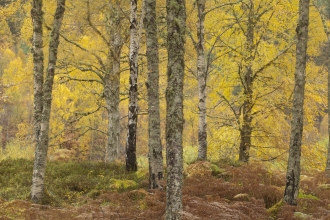Choosing wisely
Before starting your tree planting project, seek expert local guidance to make sure the site you've chosen is suitable for tree planting.
If the area is grassland rich in wildflowers, a coastal habitat, moorland or is wet and marshy, avoid planting trees. These habitats are already wonderful in their own rights - they store carbon and are important for many species - and they may also have a wildlife or historic designation.
The most suitable sites for tree planting are likely to be arable or grassland areas with few existing wildflowers, plants, or fungi. In these cases, tree planting is often the best natural solution to storing carbon. Once you've chosen the best site for your project, ensure to follow the guidelines below when choosing and planting your trees!

Guy Edwardes/2020VISION
Why it matters
While increased attention on environmental issues in the political sphere is generally positive and leads to more resource, planting trees in mass quantities without properly planning the management of woodland care can risk wasting precious resource.
You can find out more about the importance of strategic placement of trees and rewilded spaces on our Nature Recovery Networks page.
How to start
Have a look at our resources below. We have a handy flow chart to help you decide on the best course of action for planting trees, as well as list of tree species native to Staffordshire.
Resources
Think long term when it comes to size
Some trees are small enough to be grown in containers, others not so small. Make sure you know exactly how big to expect your tree to grow, and how far the canopy will spread, so that you can pick the right one for your space. You should really only grow big trees like English oak, common beech and alder if you have a very big garden.
Where should I plant it?
Take care when planting near a house or other structures. As a general rule, you should plant the tree at least its mature height away from the nearest building. Be careful with this as the root systems of some larger trees, like oak, can cause subsidence and damage drains as they grow, so make sure to think ahead. If your tree causes damage to someone else’s property, you will be liable for damages! If you are considering planting trees outside of your garden, follow our 'right tree, right place' principles further down this page.
When should I plant it?
The best time of year to plant a tree is when the roots are dormant as they are less easily disturbed by the moving process: typically, from mid-November to late March. Buy a seedling between 60-90 cm tall (a 'whip') for the quickest growth rates. Once you have your seedling, you're ready to get started!
Step-by-step planting guide:
Step 1
Make sure the roots are submerged in a bucket of water for 2 hours before planting. Exposed roots don’t do well – the root hairs dry easily and quickly die.
Step 2
Dig a hole: it should be at least double the width of the root ball. Keep the topsoil in a separate pile, if you can, and mix it with some compost. Break up the soil in the bottom of the hole. Trees over 1.5 m tall (or spindly or exposed trees) will need a little support – pop a metre-long stake firmly in the ground next to where you're planting the tree, on the side that will be facing the wind.
Step 3
Place your tree in the centre of the hole and spread the roots, making sure that it's deep enough that the soil lines up with the soil mark on the stem (this line shows where the stem ends and the roots begin).
Step 4
Spread the soil mix carefully around the roots, gently shaking the tree to make sure that the soil is in contact with the roots. Compact the soil around the tree and gently tug it to make sure it's secure. Water generously to settle the soil around the roots and tether the tree to the stake if you're using one.
Step 5
Don't forget about your tree! The first weeks and couple of years after planting are especially important. Water daily for the first two weeks, and then weekly for the first year while the tree is active (has its leaves). Regularly check the soil is firm around the tree and tear off any suckers (growths rising from the roots). Remember to loosen tethers as your tree grows, readjusting as necessary to stop ties from biting into the stem. The stake can be removed after 3 years.

Ben Hall/2020VISION
Still unsure?
We'd love to hear from you.
If you've got a question not covered on this page, or want to tell us about a major tree-planting operation happening near you, please send us an email at info@staffs-wildlife.org.uk and we'll help as best we can.










